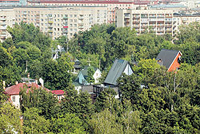Moscow can lose last rural oasis
Their wooden homes, vegetable patches and backyard geese survived Stalin's purges, World War II, a tornado, and numerous attempts to raze them. Today, the village is the capital's last oasis of tranquil rural life amid the chaos of a city on the move.

Sokol is again endangered - this time from Russia's new class of multi-millionaires.
Property is being snapped up in Moscow at such a frenzied pace that the Russian capital this year was rated the world's most expensive city.
Sokol, founded in 1923, is not immune to the property boom. But the mega-rich are more interested in its land than in its quaint wooden homes.
Meticulously carved wooden fences are making way for metal walls with security cameras. Extravagant villas now loom over the original low-slung dwellings.
60 percent of Sokol's families have lived in the village for multiple generations. But as those lower middle-class families come under pressure to sell, Sokol's future as a village of creaky wooden houses is increasingly in doubt.
Among Sokol's planners were Alexey Shchusev, the architect who later designed Lenin's mausoleum, and Pavel Florensky, a renowned theologian and artist. In 1979, the village became an official monument to Soviet-era town planning, the AP reports.
Subscribe to Pravda.Ru Telegram channel, Facebook, RSS!


